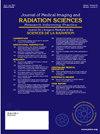A Case Study: Maxillofacial MRI of a Fetal with a Complaint of Narrowing of the Upper Alveolar Process
IF 1.3
Q3 RADIOLOGY, NUCLEAR MEDICINE & MEDICAL IMAGING
Journal of Medical Imaging and Radiation Sciences
Pub Date : 2024-10-01
DOI:10.1016/j.jmir.2024.101505
引用次数: 0
Abstract
Purpose
Tooth buds anomalies coincide with genetic disorders, and prenatal identification may contribute to a more accurate diagnosis. And fetal cleft lip and palate (CLP) is a common congenital facial malformation, which not only affects the appearance of children but also causes malnutrition in children with the difficulty of sucking milk. The purpose of the presentation was to improve the feasibility of fetal magnetic resonance imaging in visualizing intrauterine tooth buds alignment, CLP conditions and image quality.
Method
A 29-year-old pregnant woman was referred to our institution with an ultrasound report of a narrow upper alveolar process. We used 3.0T MRI Steady-State-Free-Precession (bSSFP) and Single-Shot Fast Spin-Echo (SS-FSE) sequences to examine this fetus for tooth bud abnormalities and CLP. Sagittal scanning is performed with the fetus swallowing amniotic fluid so that the tongue and palate are separated to better show the continuity of the hard and soft palate. The oblique axial position is scanned along the sagittal superior alveolar process to show the development of the tooth buds.
Result
Compared to the SS-FSE sequence, bSSFP sequence improves the SNR and contrast, and better shows the alignment of the tooth buds as well as the palate. It was finally confirmed that the fetus had a narrow upper alveolar eminence for abnormal tooth buds alignment (deciduous central incisor teeth, lateral incisor teeth and cusp incisors)and that there was no CLP.
Conclusion
The use of the bSSFP sequence to better shows fetal maxillofacial structures in the presence of amniotic fluid swallowing, also improves diagnostic accuracy and the diagnosis of associated syndromes.
病例研究:一名主诉上牙槽突狭窄的胎儿的颌面部核磁共振成像
目的 牙蕾畸形与遗传性疾病相吻合,产前鉴定有助于更准确地诊断。而胎儿唇腭裂(CLP)是一种常见的先天性面部畸形,不仅影响患儿的外观,还会造成患儿吸奶困难而营养不良。本报告旨在提高胎儿磁共振成像在观察宫内牙芽排列、CLP 情况和图像质量方面的可行性。我们使用 3.0T 核磁共振成像稳态自由回波(bSSFP)和单发快速自旋回波(SS-FSE)序列检查了该胎儿的牙蕾异常和 CLP。矢状位扫描是在胎儿吞咽羊水时进行的,这样舌头和上颚就会分开,从而更好地显示硬腭和软腭的连续性。结果与 SS-FSE 序列相比,bSSFP 序列提高了信噪比和对比度,能更好地显示牙蕾和腭的排列。结果与 SS-FSE 序列相比,bSSFP 序列提高了信噪比和对比度,能更好地显示胎儿的牙蕾排列和腭部,最终证实胎儿上牙槽突狭窄,牙蕾排列异常(落叶中切牙、侧切牙和尖切牙),且无 CLP。
本文章由计算机程序翻译,如有差异,请以英文原文为准。
求助全文
约1分钟内获得全文
求助全文
来源期刊

Journal of Medical Imaging and Radiation Sciences
RADIOLOGY, NUCLEAR MEDICINE & MEDICAL IMAGING-
CiteScore
2.30
自引率
11.10%
发文量
231
审稿时长
53 days
期刊介绍:
Journal of Medical Imaging and Radiation Sciences is the official peer-reviewed journal of the Canadian Association of Medical Radiation Technologists. This journal is published four times a year and is circulated to approximately 11,000 medical radiation technologists, libraries and radiology departments throughout Canada, the United States and overseas. The Journal publishes articles on recent research, new technology and techniques, professional practices, technologists viewpoints as well as relevant book reviews.
 求助内容:
求助内容: 应助结果提醒方式:
应助结果提醒方式:


